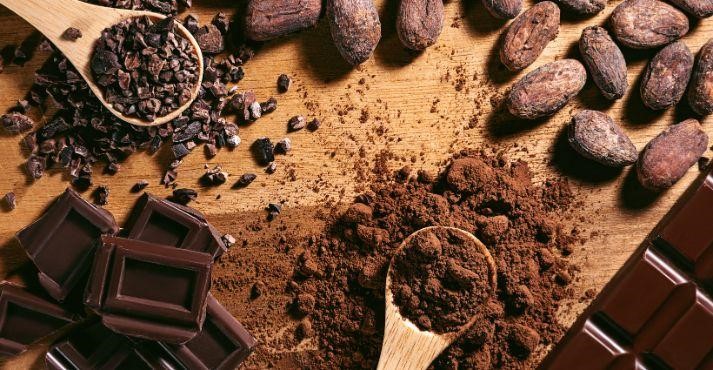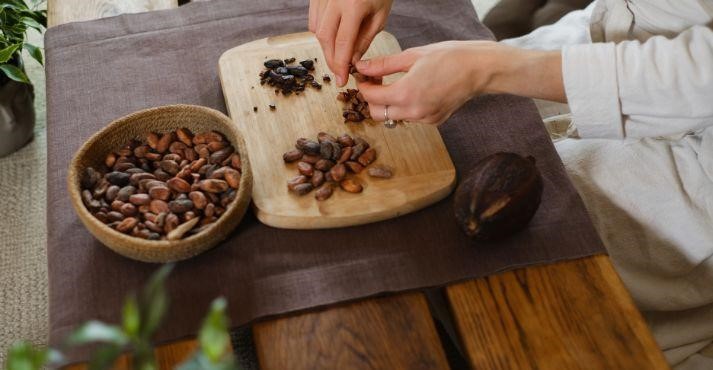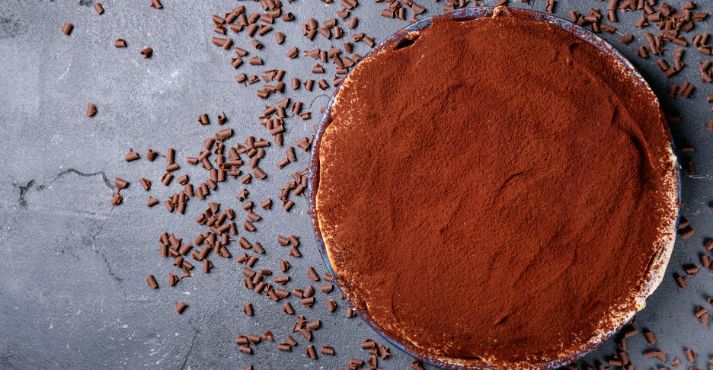Are you standing in the baking aisle, confused by “cacao powder” and “cocoa powder”? Which one to choose for your decadent brownies? You’re not alone.
Chocolate is beloved worldwide, with the global chocolate market valued at over $133.6 billion in 2024. Understanding the difference between these two similar-sounding ingredients is essential with increasing interest in healthier alternatives.
Cacao powder and cocoa powder stem from the same cacao bean, yet they differ significantly in how they’re processed, their nutritional content, and their best uses in cooking and baking.
This blog aims to clear up any confusion by explaining the difference between cacao and cocoa powder, highlighting their health benefits, and providing guidance on which one to choose for your culinary creations.
Knowing the distinction between cacao powder and cocoa powder will help you choose healthier smoothies or perfect chocolate cakes.
What is Cacao Powder?

Cacao powder is a natural product made from raw, cold-pressed cacao beans.
Unlike cocoa powder, which undergoes high-temperature processing, cacao powder is produced at low temperatures to preserve its nutritional value. This is also one of the major differentiating factors between cocoa and cacao.
Cacao beans come from the Theobroma cacao tree. Once harvested, these beans are fermented, dried, and cold-pressed to remove the fat (cacao butter). The remaining solids are then finely milled into a powder.
This minimal processing helps retain many of the beans’ natural nutrients, making cacao powder a popular and healthy choice, as there is a growing trend of consumers choosing low-sugar and healthier chocolate alternatives.
Essential Nutrients in Cacao Powder
- Antioxidants: Cacao powder is rich in flavonoids, an antioxidant that helps fight free radicals in the body. These antioxidants can reduce inflammation, improve heart health, and lower the risk of certain chronic diseases.
- Magnesium: Magnesium is crucial for many bodily functions, including muscle and nerve function, blood sugar control, and bone health. Cacao powder is one of the best plant-based sources of this essential mineral.
- Iron is vital for producing hemoglobin, a protein in red blood cells that carries oxygen throughout the body. The iron in cacao powder is more easily absorbed than other plant sources, making it an excellent option for vegetarians and vegans.
Health Benefits
- Improved Heart Health: Cacao powder’s antioxidants can help lower blood pressure and improve blood flow to the heart, reducing the risk of cardiovascular diseases.
- Reduced Inflammation: Flavonoids in cacao powder have anti-inflammatory properties that can help reduce inflammation throughout the body.
- Enhanced Mood: Cacao powder contains compounds like serotonin, tryptophan, and phenylethylamine, which can boost mood and promote well-being.
Including cacao powder in your diet can provide these nutrients and boost your overall health.
Common Uses
Cacao powder’s bitter flavor and nutrient density make it a versatile ingredient in various recipes:
- Smoothies: Add a tablespoon of cacao powder to your morning smoothie for a nutrient boost and a rich, chocolatey flavor.
- Desserts: To keep raw desserts healthy and delicious, use cacao powder in energy balls, brownies, or chocolate bars.
- Raw Food Dishes: Incorporate cacao powder into raw food recipes to improve their flavor and nutritional content without cooking.
Understanding the difference between cacao and cocoa is critical to making informed choices in your kitchen.
What is Cocoa Powder?

Cocoa powder is a popular ingredient made from roasted cacao beans, processed at higher temperatures than cacao powder.
This process involves roasting the fermented and dried cacao beans at high temperatures, bringing out a sweeter flavor and reducing the overall nutritional content.
Cocoa powder is created by roasting and grinding the beans to remove the fat, known as cocoa butter. The remaining solids are then ground into a fine powder commonly used in baking and other recipes.
Nutrient Content Comparison
Cocoa powder has fewer antioxidants and nutrients than cacao powder due to its high-temperature food processing. However, it still contains some beneficial nutrients, including:
- Flavanols: Although reduced, cocoa powder contains flavanols, which have antioxidant properties.
- Magnesium: It retains a moderate amount of magnesium, essential for muscle and nerve function.
- Iron: Cocoa powder also contains iron in lesser amounts than cacao powder.
Health Benefits
Despite some nutrient losses during processing, cocoa powder still offers several health benefits:
- Heart Health: Cocoa powder’s flavanols can help improve blood flow and lower blood pressure, contributing to better cardiovascular health.
- Mood Boost: Cocoa powder contains compounds like serotonin and phenylethylamine, which can improve mood and promote feelings of happiness.
Common Uses
Cocoa powder’s sweeter flavor and smoother texture make it a favorite in many recipes:
- Baking: Cocoa powder is a staple in baking, used in cakes, cookies, brownies, and other chocolate desserts for a rich, chocolatey flavor.
- Hot Cocoa: Mix cocoa powder with milk and sugar to create a comforting hot cocoa drink, perfect for cold days.
- Chocolate Desserts: Cocoa powder is essential for making chocolate sauces, ganache, puddings, and frostings.
Including cocoa powder in your diet can still provide health benefits, even if it’s less nutrient-dense than cacao powder. By incorporating cacao and cocoa into your cookery collection, you can enjoy the best of both worlds—delicious flavors and health benefits.
How Cacao Beans Are Processed?
The journey from cacao beans to cacao powder and cocoa powder involves several crucial steps, each impacting the final product’s flavor, texture, and nutritional content.
1. Harvesting and Fermentation:
- Harvesting: Cacao beans are harvested from the Theobroma cacao tree. The beans are found inside large, pod-like fruits, each containing 20-60 beans surrounded by a sticky, sweet-tart pulp.
- Fermentation: The beans and some of the surrounding pulp are placed in bins and covered for several days. This fermentation process develops the beans’ distinctive chocolate flavor and aroma.
2. Drying:
- After fermentation, the beans are spread out and dried under the sun for several days. This step reduces the moisture content and prepares the beans for further processing.
3. Roasting (for Cocoa Powder):
- Roasting: For cocoa powder, the dried beans are roasted at high temperatures. This roasting process heightens the beans’ flavor, giving cocoa its characteristic rich and sweet taste. It also reduces some of the beans’ nutritional content.
4. Grinding:
- Crushing: The roasted or dried beans are crushed to separate the outer shells from the nibs, which are the edible parts of the bean.
- Grinding: The nibs are ground into a thick paste known as chocolate liquor. Cacao powder is ground at low temperatures to preserve nutrients. The liquor is further processed into cocoa powder to remove most of the fat (cocoa butter), resulting in a fine powder.
Understanding the steps from bean to powder helps explain the difference between cacao and cocoa products. The minimal processing of cacao powder retains more nutrients, while the roasting process for cocoa powder improves flavor but reduces nutritional content.
By knowing these processes, you can better appreciate the cacao vs cocoa distinction and make informed choices in your kitchen.
Differences Between Cacao Powder and Cocoa Powder

Understanding the differences between cacao powder and cocoa powder is essential for making informed choices in your cooking and baking. These differences stem primarily from their distinct processing methods, nutritional content, flavor profiles, and cost.
Processing Methods
1. Cacao Powder:
-
- Fermentation: The journey starts with the fermentation of cacao beans, which develops their flavor and texture.
- Drying: The fermented beans are then sun-dried to reduce moisture.
- Cold-Pressing: The dried beans are cold-pressed to separate the fat (cacao butter) from the solids. This process preserves the beans’ natural nutrients.
- Grinding: The remaining solids are finely ground into cacao powder. The low-temperature processing ensures that the nutrients are retained, resulting in a product rich in antioxidants and other beneficial compounds.
2. Cocoa Powder:
-
- Fermentation and Drying: Like cacao powder, the beans are fermented and dried.
- Roasting: The dried beans are roasted at high temperatures, enhancing their flavor and reducing some of the nutritional content.
- Grinding: The roasted beans are ground into a thick paste known as chocolate liquor. The liquor is then pressed to remove most of the cocoa butter, leaving behind the solids ground into cocoa powder—this high-temperature process results in a smoother and sweeter product.
Nutritional Comparison of Cacao vs Cocoa
| Nutrient | Cacao Nibs (1 oz) | Raw Cacao Powder (1 tbsp) | Unsweetened Cocoa Powder (1 tbsp) | |
|---|---|---|---|---|
| 1 | Calories | 190 | 128 | 25 |
| 2 | Fat | 13g | 9g | 1.5g |
| 3 | Saturated Fat | 6g | 6g | 0.5g |
| 4 | Carbohydrates | 13g | 8g | 8g |
| 5 | Fiber | 9g | 4g | 3.5g |
| 6 | Sugar | 1g | 1g | 1g |
| 7 | Protein | 6g | 8g | 2g |
| 8 | Iron (mg) | 6.8 | 4mg | 2mg |
| 9 | Magnesium (mg) | 160 | 64mg | 25mg |
| 10 | Calcium (mg) | 40 | 26mg | 12mg |
| 11 | Potassium (mg) | 640 | 200mg | 100mg |
Flavor Profiles
- Cacao Powder: Has a more intense, bitter flavor due to the minimal processing and lack of added sugars. It is often used in smoothies, raw desserts, and other recipes where its spicy flavor can be balanced with other ingredients.
- Cocoa Powder: Has a milder, sweeter taste, making it ideal for baking. The roasting process boosts the natural sweetness of the beans, making cocoa powder perfect for cakes, brownies, and hot cocoa.
Cost and Availability
- Cost: Cacao powder is generally more expensive than cocoa powder. This is due to its less intensive processing and the higher nutrient content it retains. The market often positions cacao powder as a premium, health-focused product.
- Availability: Both cacao and cocoa powders are widely available in grocery stores and online. However, cocoa powder is more commonly found due to its widespread baking use and lower cost. Cacao powder, while increasingly popular, is typically found in health food stores or the health food sections of supermarkets.
Understanding these differences helps you choose the best ingredients for your recipes and health goals. Whether you prefer the nutrient-dense cacao powder or the sweeter, more versatile one, knowing the difference between cocoa and cacao ensures you get the suitable ingredient for your needs.
How to Choose Between Cacao Powder and Cocoa Powder
Choosing between cacao powder and cocoa powder depends on your health goals, taste preferences, and recipe requirements. Here’s a guide to help you make the best decision.
Based on Health Goals
If you’re focused on maximizing your nutritional intake, cacao powder is the better option. It’s minimally processed, retaining more antioxidants, magnesium, and iron. These nutrients can help improve heart health, reduce inflammation, and boost overall well-being.
Cacao powder is especially beneficial for those following a vegan or raw food diet, as it provides essential nutrients that are sometimes hard to find in plant-based foods.
Based on Taste Preferences
Taste is a significant factor in deciding between cacao and cocoa. Cacao powder has a more intense, bitter flavor due to its minimal processing. It’s perfect for those who enjoy dark chocolate and want to add a robust chocolate flavor to their smoothies, raw desserts, and other recipes.
On the other hand, cocoa powder is milder and sweeter, making it ideal for those who prefer a less bitter taste. Its flavor is well-suited for baking, hot cocoa, and chocolate desserts where a sweeter, more palatable chocolate flavor is desired.
Based on Recipe Requirements
Different recipes call for different types of chocolate flavor and texture:
- Cacao Powder: Best for recipes where a strong, pure chocolate flavor is needed. Use it in smoothies, energy balls, raw desserts, and other no-bake recipes to maximize its health benefits and intense flavor.
- Cocoa Powder: Ideal for baking. Its smooth texture and sweeter taste work well in cakes, cookies, brownies, and hot cocoa. The high-temperature processing makes it more stable for baking, ensuring a consistent and pleasant chocolate flavor.
Choosing Between Cacao Powder and Cocoa Powder

When selecting cacao and cocoa powder, the decision hinges on your taste preferences, recipe requirements, and health considerations. Let’s explore how you can make an informed choice and even experiment in the kitchen.
Flavor Considerations
Cacao Powder:
- Bold and Intense: If you prefer a rich, intense chocolate flavor with slightly bitter notes, cacao powder is the ideal choice.
- Authenticity: Cacao powder captures the raw essence of chocolate, offering a genuine and unadulterated taste.
Cocoa Powder:
- Milder and Sweeter: Cocoon powder is the way to go if you enjoy a smoother and slightly sweeter chocolate experience.
- Versatility: Cocoa powder’s more subdued flavor profile makes it versatile, blending seamlessly into various recipes.
Recipe Requirements
Cacao Powder:
- Decadent Desserts: Opt for cacao powder when baking decadent desserts like rich brownies, dark chocolate cakes, or intensely flavored truffles.
- Raw Treats: Consider cacao powder for raw or no-bake recipes, where its unprocessed nature shines.
Cocoa Powder:
- Everyday Treats: Choose cocoa powder for everyday treats like chocolate chip cookies, chocolate milkshakes, or when making a quick hot chocolate.
- Versatile Baking: Cocoa powder’s versatility makes it suitable for a wide range of recipes, including both sweet and savory dishes.
Health Considerations
Cacao Powder:
- Higher Antioxidants: If you prioritize a higher antioxidant content for potential health benefits, cacao powder is a great choice.
- Nutrient Density: Cacao powder tends to be slightly higher in nutrients like magnesium, iron, and fiber.
Cocoa Powder:
- Balanced Benefits: While slightly lower in antioxidants, cocoa powder still provides health benefits and contributes to heart health and overall well-being.
- Subtle Sweetness: Cocoa powder can be preferred for those aiming for a balanced chocolate flavor without the intense bitterness.
Kitchen Experiments with Chocolate Powders
Feel free to Experiment with Chocolate Powders in the kitchen. You can:
- Substitute Freely: In many recipes, cacao and cocoa powder can be substituted for one another. Experiment to find the balance that suits your taste.
- Blend Them: Create a unique cacao and cocoa powder blend for a balanced flavor profile that suits your preferences.
- Explore Savory Dishes: Don’t limit chocolate powders to sweets—add them to savory dishes like chili or mole sauces for a delightful twist.
Cacao Powder vs. Cocoa Powder – FAQs
Can I substitute cacao powder for cocoa powder?
Yes, you can substitute cacao powder for cocoa powder in most recipes. However, be aware that cacao powder has a more bitter flavor and higher nutritional content, which might slightly alter the taste and texture of your dish.
Is 100% cacao the same as cocoa powder?
No, 100% cacao refers to products made from pure cacao beans without additives. Cocoa powder, made from cacao beans, typically undergoes higher temperature processing and may contain added ingredients like sugar and dairy.
Why is cacao more expensive than cocoa?
Cacao is more expensive because it undergoes minimal processing, preserving its nutritional content. This low-temperature processing is more labor-intensive and less common, leading to higher costs than cocoa powder.
Conclusion
Understanding the difference between cacao powder vs. cocoa powder helps you make informed choices in your kitchen.
With its high nutrient content and intense flavor, Cacao powder is ideal for health-focused recipes. Cocoa powder, sweeter and milder, works well in baked goods and traditional chocolate desserts.
By considering your health goals, taste preferences, and specific recipe needs, you can select the right powder for your culinary creations. Whether you choose cacao or cocoa, both offer unique benefits and can enhance your dishes in different ways.












